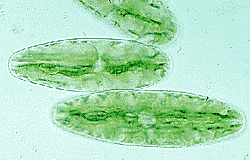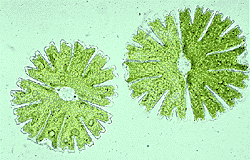 |
 |
The Desmidiales comprise about 40 genera of more than 10,000 species, making them a larger group than all the other charophytes combined. They are usually divided into two families based on the structure of the cell wall. The Mesotaeniaceae, such as Netrium pictured above, have a homogeneous wall, while the Desmidiaceae, such as Microasterias pictured below, have a wall composed of two compartments connected by a narrow isthmus, and straddled by a single plastid. It is this latter, larger family which gives the desmids their name, from the Greek word "desmos" meaning "bond".
 |
 |
Desmid Diversity : On the left, Netrium, a representative of the homogeneous walled Mesotaeniaceae group of desmids. On the right, Microasterias, a representative of the Desmidiaceae, the other major group which has a cell with two major compartments.
Desmids are primarily found in freshwater habitats, such as ponds, rivers, and lakes. There, they may live as phytoplankton, on the bottom as benthic dwellers, or on the submerged portions of plants. They may also be found in saline waters, or in snow or ice. While most desmids are unicellular, many species grow as long filamentous colonies.
Like many other charophytes desmids have no flagella; they were lost at some point in the group's evolution. Reproduction therefore, cannot rely on motile gametes, but rather two cells will meet and join in a process called conjugation. Once the two desmids have joined, their cytoplasm fuses into a single diploid cell, the zygote, which encases itself in a thick wall. Later, the zygote will undergo meiosis to produce new haploid individuals. Growing desmid cells therefore have only a single set of chromosomes, and the zygote is the only diploid cell in the life cycle.
The thick-walled zygospore which encases the zygote, is highly ornamented and very durable. As such, they have been found fossilized in Jurassic and Cretaceous deposits, and have been used to reconstruct paleoclimates.

Photos of Microasterias thomasiana and Netrium digitus courtesy Richard M. McCourt

